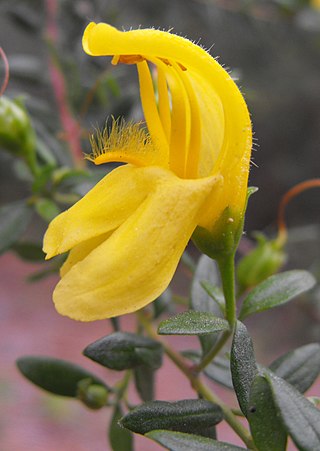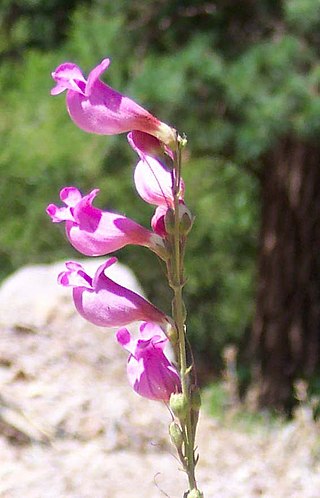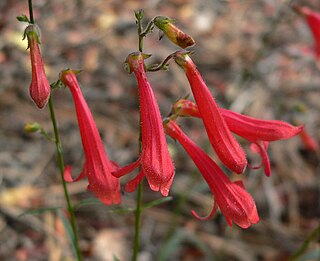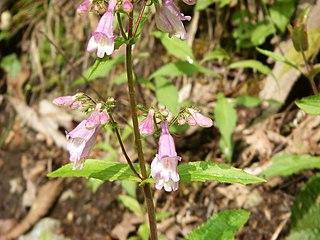
Keckiella antirrhinoides is a species of flowering shrub in the plantain family known by the common names snapdragon penstemon and chaparral beardtongue.

Keckiella corymbosa is a species of flowering shrub in the plantain family known by the common names redwood keckiella, red beardtongue, and red shrubby penstemon.

Nothochelone is a monotypic genus of flowering plants in the plantain family containing the single species Nothochelone nemorosa, which is known by the common name woodland beardtongue. Originally described as Penstemon nemorosus, the plant is very similar in appearance to the penstemons, but was separated and placed into its own genus on the basis of slight morphological differences, such as winged seeds.

Penstemon centranthifolius is a species of penstemon known by the common name scarlet bugler. It is native to California and parts of Mexico, where it grows in many types of dry habitat from coast to desert, such as chaparral and oak woodland.
Penstemon cinicola is a species of penstemon known by the common name ash penstemon. It is native to northeastern California and southern Oregon, where it grows in forests and plateau habitat. It is a perennial herb with upright branches 40 centimeters (16 in) maximum height. The leaves are 3 to 6 centimeters long, linear in shape, folded lengthwise, and curved backwards. The inflorescence produces tubular flowers with wide lipped mouths. The flower is blue-purple in color, just under one centimeter long, and hairless except for hairs on the floor of the mouth and on the staminode.

Penstemon clevelandii is a species of penstemon known by the common name Cleveland's beardtongue. It is native to southern California and Baja California, where it grows in mountain and desert habitat such as scrub, woodland, and chaparral. It is a perennial herb with upright, branching stems 70 centimeters in maximum height. The thick leaves are oval in shape, sometimes toothed, and 2 to 6 centimeters in length. The inflorescence produces tubular flowers with expanded, lipped mouths. The flower is pink to magenta in color, up to 2.4 centimeters in length, and somewhat glandular on the outer surface.

Penstemon deustus is a species of penstemon known by the common names hotrock penstemon and scabland penstemon. It is native to much of the northwestern United States from the Pacific Northwest to Wyoming, where it grows in many types of forest and open plateau habitat, often on soils heavy in volcanic rock or on limestone outcrops. It is a perennial herb with upright branches approaching 40 centimetres (16 in) in maximum height. The thick leaves are lance-shaped to oval or round, and are sharply toothed. Most leaves occur low on the plant. The inflorescence produces tubular flowers with lipped, five-lobed mouths. The glandular flower is cream in color with dark lining and reaches 1.5 cm in length.

Penstemon floridus is a species of flowering plant in the plantain family known by the common names Panamint beardtongue and rose penstemon.

Penstemon labrosus is a species of penstemon known by the common name San Gabriel beardtongue. It is native to the Transverse Ranges of southern California, including the San Gabriel Mountains, and the Peninsular Ranges to the south, its distribution extending into Mexico. It grows in forest and woodland habitat. It is a perennial herb growing erect to about 70 centimeters tall. The long, paired leaves are linear in shape with rolled, untoothed edges, and reach over 8 centimeters in maximum length. The inflorescence produces bright red to orange or yellowish flowers 3 to 4 centimeters long. The upper lip is hood-shaped and the lower is divided into 3 narrow lobes which are sometimes reflexed. The flower is hairless, including the staminode.
Penstemon personatus is an uncommon species of penstemon known by the common name closethroat beardtongue.

Penstemon procerus is a species of penstemon known by the common name littleflower penstemon. It is native to western North America from Alaska to California to Colorado, as far east in Canada as Manitoba, where it grows in mountain habitat such as meadows, often in alpine climates. This herbaceous perennial forms mats of herbage with some erect stems reaching about 40 centimeters in maximum height. There are several varieties which vary in morphology, some more decumbent than others, some of which are known commonly as pincushion penstemons for their matted forms. In general, the leaves are lance-shaped to oval, plentiful around the base of the plant with smaller ones arranged in opposite pairs along the stem. The inflorescence is made up of one or more clusters of tubular flowers with lipped, lobed mouths. Each flower is no more than one centimeter in length and is purple to blue in color, often with a white throat. The outside of the flower is generally hairless, while the inside may be lined with white or yellowish hairs.

Penstemon pseudospectabilis a species of penstemon. It's native to the southwestern United States, where it grows in desert and plateau habitat types, such as sandy washes, scrub, and woodland. The plant is generally a shrub growing to one meter, with many erect stems. The thin leaves are oval with wide, pointed tips and serrated edges. They are arranged oppositely in pairs, many are completely fused at the bases about the stem, forming a disc. The inflorescence bears tubular flowers with expanded, lobed mouths and glandular hairs on most surfaces, except the hairless staminode. The flower grows to 2.5 centimeters and is reddish pink.

Penstemon rostriflorus is a species of penstemon known by the common names beaked penstemon, Bridge penstemon, or Bridges' penstemon.

Penstemon utahensis is a species of penstemon known by the common names Utah beardtongue and Utah penstemon. It is native to the southwestern United States, where it grows in scrub, woodland, and canyons. It is a perennial herb growing erect to a maximum height near half a meter. The thick leaves are located around the base of the plant and in opposite pairs along the stem. The upper leaves are lance-shaped and often folded lengthwise, measuring up to 5.5 centimeters long. The showy inflorescence bears many bright red-pink flowers up to 2.5 centimeters in length. They are cylindrical, tubular, or funnel-shaped with wide, lobed mouths, and mostly hairless to slightly hairy and glandular.
Erythranthe hymenophylla, synonym Mimulus hymenophyllus, is a species of flowering plant in the lopseed family known by the common names thinsepal monkeyflower and membrane-leaf monkeyflower. It is native to Hells Canyon on the border between Oregon and Idaho in the United States. It has also been reported from Montana.

Penstemon barrettiae is a species of flowering plant in the plantain family known by the common name Barrett's beardtongue or Barrett's penstemon. It is endemic to a small part of the Pacific Northwest of North America.

Penstemon degeneri is a species of flowering plant in the plantain family known by the common name Degener's beardtongue. It is endemic to Colorado in the United States, where it occurs in and around the Arkansas River Canyon in Fremont, Custer, and Chaffee Counties.
Silene seelyi is a species of flowering plant in the family Caryophyllaceae known by the common names Seely's catchfly and Seely's silene. It is endemic to Washington state in the United States, where it is limited to the Wenatchee Mountains of Chelan and Kittitas Counties.

Penstemon canescens is a species of penstemon in the family Plantaginaceae. P. canescens is known by the common names Eastern gray beardtongue or Appalachian beardtongue. It is native to woodlands, forest edges, and roadsides of the southeastern United States and flowers May through July. It is a perennial herb producing stems reaching one meter in maximum height. Penstemon canescens has been used by Native Americans for thousands of years.

Penstemon eriantherus is a species of flowering plant in the plantain family known by the common names fuzzytongue penstemon and crested beardtongue. It is native to western North America, where it occurs in western Canada and the northwestern and north-central United States.

















